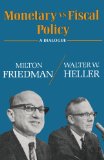Difference Between Fiscal and Monetary policy
 Fiscal Policy vs Monetary Policy
Fiscal Policy vs Monetary Policy
Fiscal policy and monetary policies are instruments utilized by governments to give impetus to the economy of a nation and sometimes they are used to curb the excess growth. The fiscal policy is the underlying principle through which the government controls the economy with the collection and expenditure of money. This is revealed in the government’s fiscal policy of a particular period.
The government engages in manipulating the available fund within the economy. This is described in the monetary policy of the government. It deals with the issuing of currency and administration of banks for smooth operations. A good flow of money enables customers to have more cash at hand and in turn encourages spending.
The fiscal policy relates with the programs and plans of the government and creates an increasing demand for workers resulting in lowering of unemployment position. The automatic fiscal plans correct the sliding down of economy, like the unemployment insurance to give relief to persons who lose jobs. Tax cuts are brought in to give back more money to business and consumers which they can spend in turn to strengthen the economy.
The fiscal policy revolves around the economic position of the nation and the related strategy to impose taxes to make maximum use of fund. This is not a one time affair but goes on changing every year to suit the position of the economy and its needs during the specific period.
The monetary policy differs with the fiscal policy on the ground that it is exclusively for banks and the circulation of money in an efficient way. This is also changed every year on the demand and supply of the money and makes effect on the rate of interest on loans. This monetary policy acts as the key regulator through the key bank of the nation as the Federal Reserve System in US.
Fiscal policy is fundamentally an attempt of the nation to give direction to the economy through manipulation of tax structures. Whereas, the monetary policy is the procedure by which the nation or its key bank influences the supply of fund, rates of interest and so on. The main objectives of both the procedures are attainment of growth of economy and its stability.
In the monetary policy, the central bank attempts to bring in four principles to either increase or reduce money supply to make a change in the structure. The primary principle is to change the cash reserve ratio of commercial banks. This restraint compels banks to maintain a deposit at the central bank. The increase in the ratio means dearth of funds at the hands of commercial banks, which makes loans to consumers difficult. Accordingly interest rates on short-term borrowings are settled. The central banks also employ the process of buying or selling of government bonds to control the supply of money in the market. These are basic differences between fiscal policy and monetary policy of a country.
Summary
1. Fiscal policy gives the direction of economy of a nation. Monetary policy controls the supply of money in the nation.
2. Fiscal policy relates to the economic position of a nation. Monetary policy focuses on the strategy of banks.
3. Fiscal policy administers the taxation structure of the nation. Monetary Policy helps to stabilize the economy of the country.
4. Fiscal policy speaks of the government’s economic program. Monetary policy sets the program of key banks of the nation.
- Difference Between Noodles and Spaghetti - December 2, 2009
- Difference Between Debt and Deficit - November 13, 2009
- Difference Between Mortgage Insurance and Life Insurance - November 6, 2009
